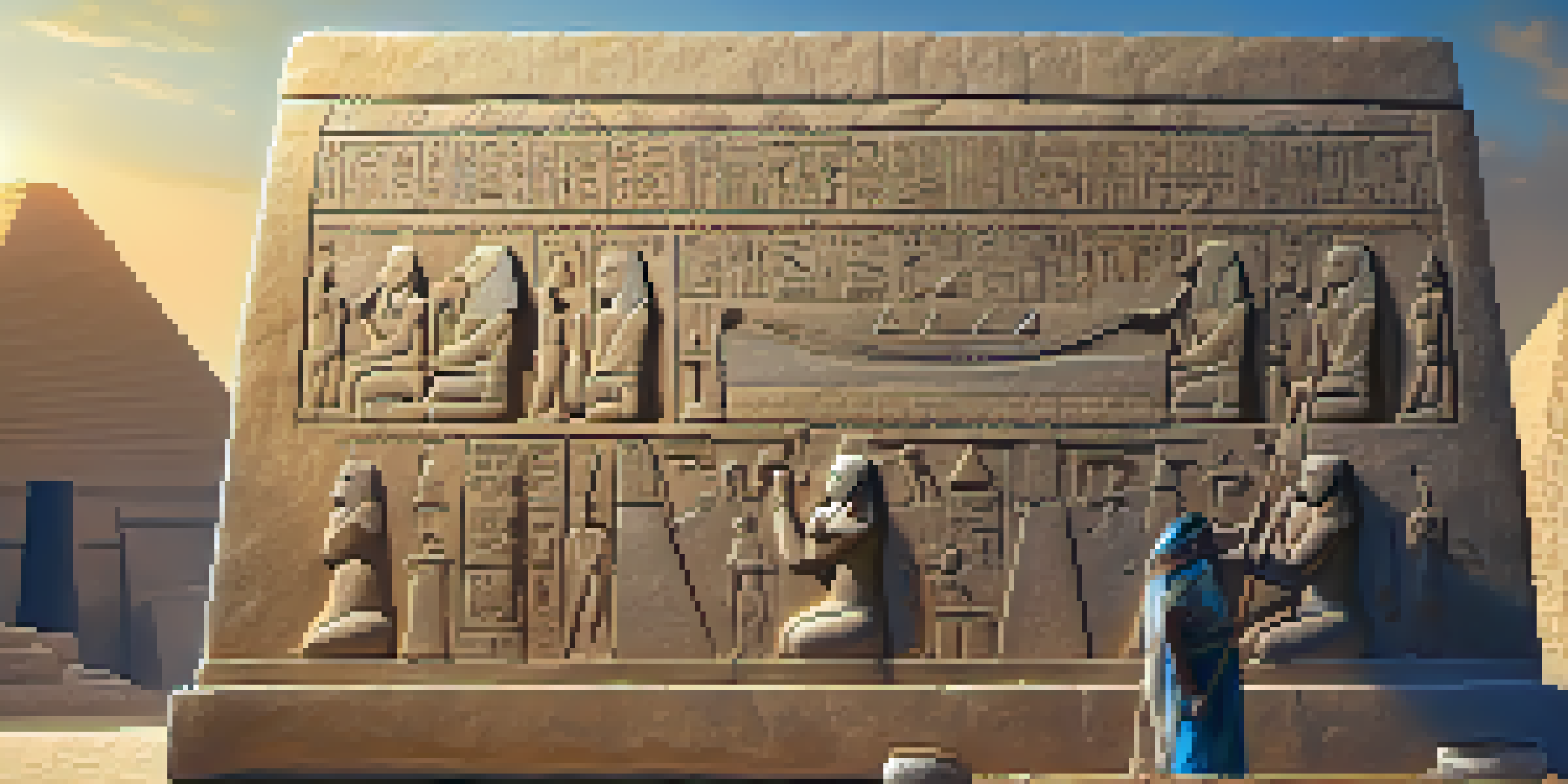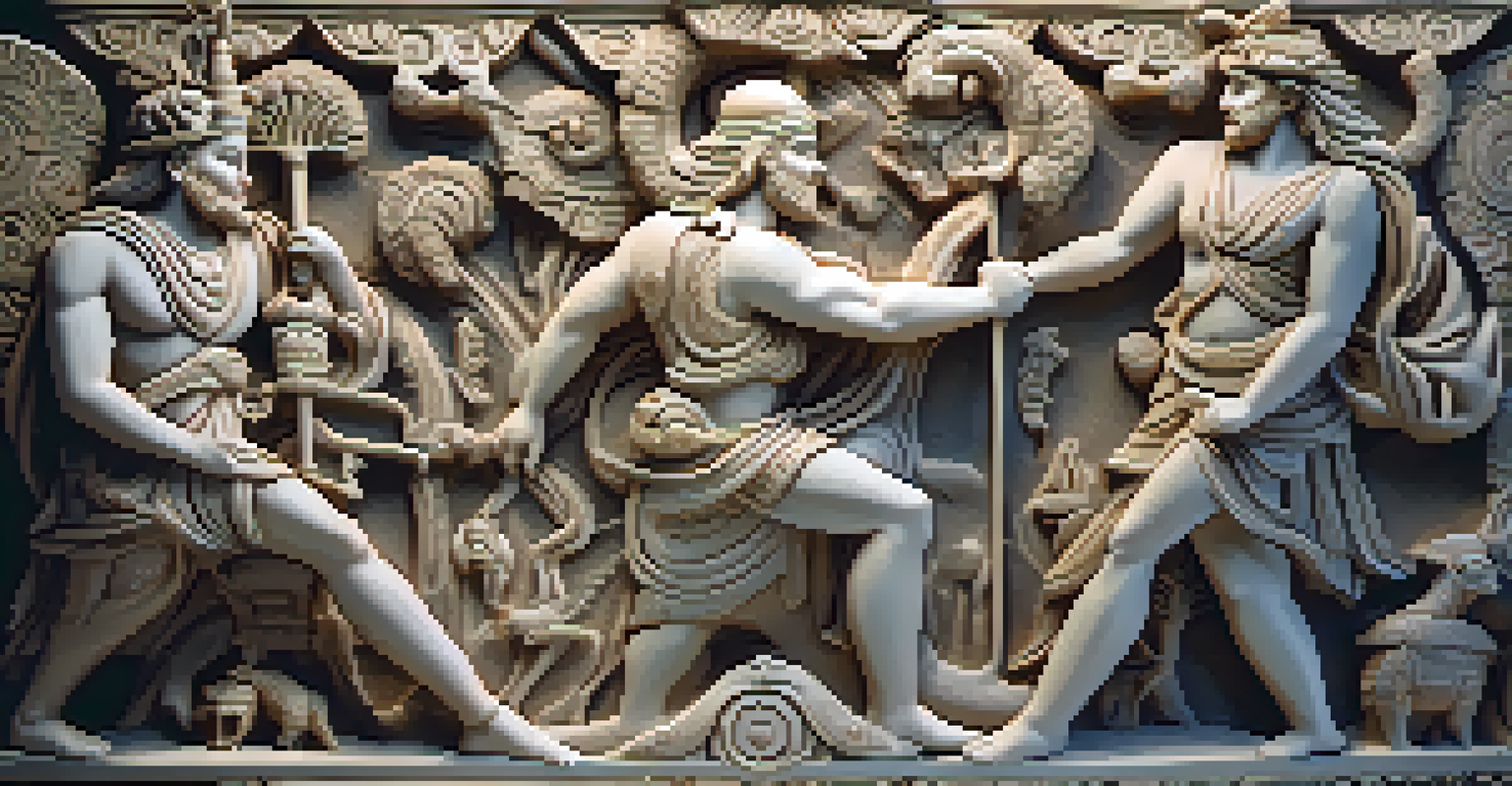Stone Carving Techniques: From Ancient Egypt to Today

The Origins of Stone Carving in Ancient Egypt
Stone carving dates back to ancient Egypt, where artisans crafted intricate sculptures and monuments. The Egyptians mastered the art, creating impressive structures like the pyramids and temples that still stand today. They used simple tools like chisels made from copper and stone to shape their material with precision.
Every artist dips his brush in his own soul, and paints his own nature into his pictures.
One fascinating aspect of Egyptian stone carving is the use of hierarchical proportions, where figures were scaled according to their social status. This technique not only showcased the skills of the artisans but also conveyed significant cultural messages. The carvings often depicted gods, pharaohs, and daily life, providing invaluable insights into their civilization.
The methods developed by Egyptian craftsmen laid the groundwork for future generations. Their techniques, such as the use of scaffolding and precise measurements, continue to influence stone carving today, demonstrating the timelessness of their artistry.
Tools and Materials: The Essential Elements of Carving
The tools used in stone carving have evolved significantly over the years, starting from simple hand tools to advanced machinery. In ancient times, artisans relied on chisels, hammers, and abrasives to shape stones like limestone, granite, and marble. Each type of stone required a specific approach, as some are softer and easier to carve than others.

In modern times, stone carvers incorporate power tools such as pneumatic chisels and diamond saws, which allow for greater precision and speed. However, many artisans still appreciate the traditional methods, believing that hand tools create a unique connection between the artist and the stone. This blend of old and new techniques brings a rich diversity to contemporary stone carving.
Ancient Techniques Shape Modern Art
The stone carving methods developed by ancient Egyptian artisans laid the foundation for contemporary practices, blending traditional craftsmanship with modern technology.
Understanding the properties of different stones is vital for any carver. For instance, marble is favored for its beauty and translucence, while granite is known for its durability. This knowledge not only enhances the aesthetic appeal of the finished piece but also ensures that the work stands the test of time.
Techniques: From Relief Carving to Free-Standing Sculptures
Stone carving encompasses a variety of techniques, including relief carving and free-standing sculptures. Relief carving involves creating a design that protrudes from the background stone, commonly seen in ancient temple walls. This technique allows for intricate storytelling through images, capturing moments in time.
Art is not freedom from discipline, but disciplined freedom.
In contrast, free-standing sculptures are three-dimensional works that can be viewed from multiple angles. Famous examples include Michelangelo's David and the statues in the ancient Greek Parthenon. This technique requires a deep understanding of form, balance, and anatomy to create pieces that are not only visually appealing but also structurally sound.
Both techniques require patience and skill, as the carver must remove material carefully to achieve the desired effect. As with any art form, practice is essential, and many stone carvers spend years honing their craft to master these techniques.
Cultural Significance: Stone Carving Across Civilizations
Throughout history, stone carving has held significant cultural importance across various civilizations. In ancient Rome, for instance, stone carvings were essential for commemorating victories and honoring deities. The Romans developed their own unique styles, integrating influences from the Greeks while also adding their flair.
Similarly, in Asia, stone carving has played a vital role in religious and artistic expression. In India, intricate carvings adorn temples, depicting gods and mythical creatures, while in China, stone seal carving is a revered art form with deep historical roots. These cultural expressions highlight how stone carving transcends mere aesthetics, serving as a medium for storytelling and spirituality.
Cultural Significance Across Civilizations
Stone carving serves as a powerful medium for storytelling and spirituality, reflecting the cultural identities and artistic expressions of various civilizations throughout history.
Today, stone carving continues to reflect cultural identities around the world. Artists often draw inspiration from their heritage, blending traditional techniques with modern styles to create pieces that resonate with contemporary audiences while honoring their roots.
Modern Innovations: The Future of Stone Carving
The world of stone carving is experiencing a renaissance, thanks to modern innovations that marry tradition with technology. CNC (Computer Numerical Control) machines are now widely used to cut and shape stone with incredible precision, allowing artists to explore designs that were once impossible. This technology opens up new avenues for creativity while maintaining the craftsmanship of the past.
Additionally, the rise of digital modeling has transformed the design process, enabling artists to visualize their ideas before they even touch the stone. This method not only saves time but also reduces material waste, making it a more sustainable practice. As artists embrace these tools, they continue to push the boundaries of what is possible in stone carving.
However, the heart of stone carving remains unchanged. The tactile nature of working with stone and the satisfaction of creating something tangible still draws many artists to this ancient craft. The future of stone carving is bright, as it adapts to new technologies while preserving its rich history.
Famous Stone Carvers: Legends and Their Legacies
Throughout history, many stone carvers have made their mark, leaving behind legacies that continue to inspire. Michelangelo is perhaps the most renowned, known for his masterpieces like the Pietà and the towering David. His ability to breathe life into marble set a high standard for aspiring artists, showcasing the potential of stone as a medium for profound expression.
Another notable figure is Henry Moore, a British sculptor whose abstract forms revolutionized modern sculpture. Moore's works often reflected the human experience and the natural world, emphasizing the organic connection between stone and human emotion. His innovative approach has influenced countless artists and reshaped the perception of stone carving.
Innovation Meets Tradition in Carving
Modern innovations like CNC machines and digital modeling are revolutionizing stone carving, allowing artists to explore new designs while preserving the craft's rich heritage.
These legends, along with many others, remind us of the power of stone carving as an art form. Their contributions have not only advanced techniques but also enriched cultural narratives, ensuring that the craft remains vibrant and relevant in today's artistic landscape.
Conclusion: The Timeless Art of Stone Carving
Stone carving is more than just a craft; it is a timeless art form that connects us to our past. From the monumental works of ancient Egypt to contemporary sculptures, the techniques and tools may have evolved, but the passion and creativity behind the art remain constant. Each piece tells a story, inviting viewers to appreciate the skill and dedication involved.
As we look to the future, the fusion of traditional methods with modern technology promises exciting developments in the realm of stone carving. Artists are continuously finding ways to innovate while paying homage to the rich history of their craft. This balance of old and new ensures that stone carving will continue to thrive for generations to come.

Ultimately, the art of stone carving offers a unique way to engage with history, culture, and human emotion. Whether admired in a museum or created in a studio, each carved stone holds a piece of our shared heritage, reminding us of the enduring beauty of this ancient practice.